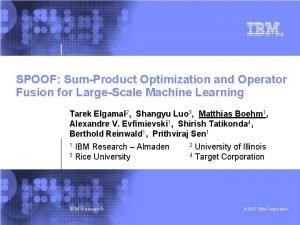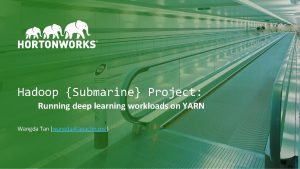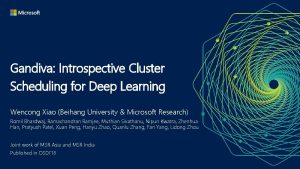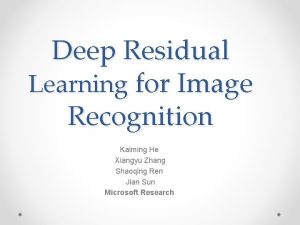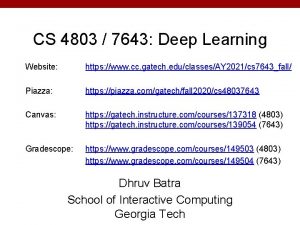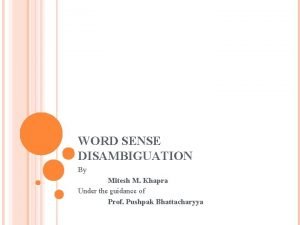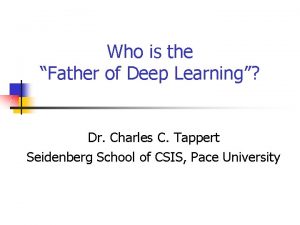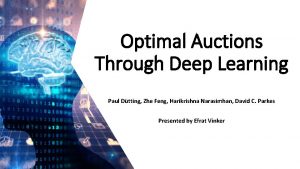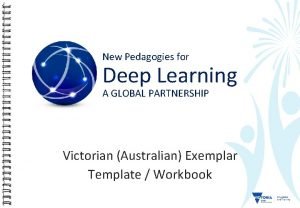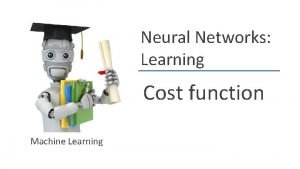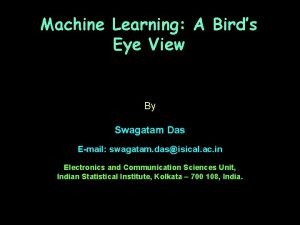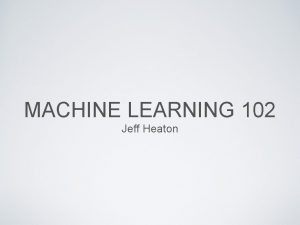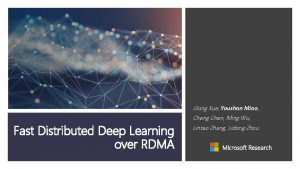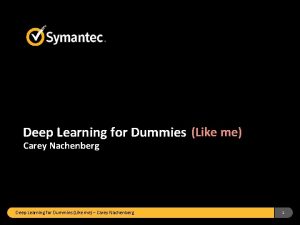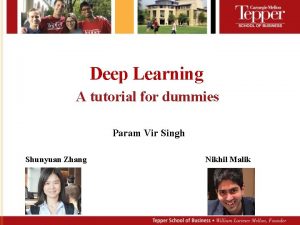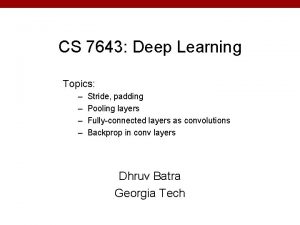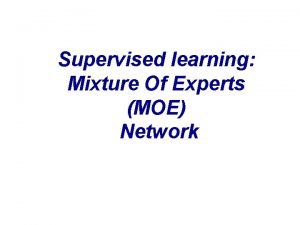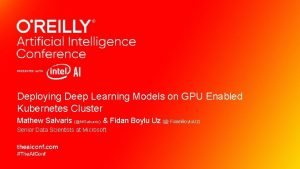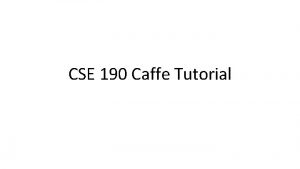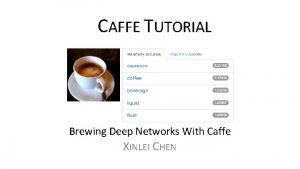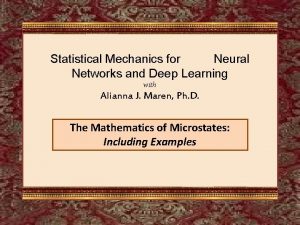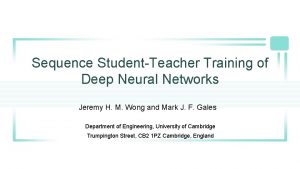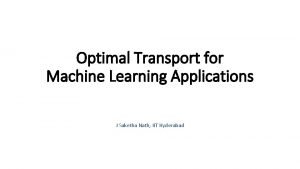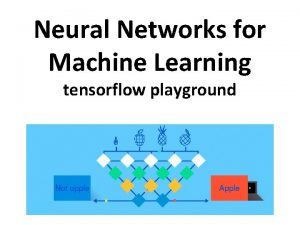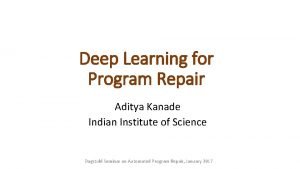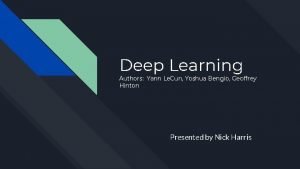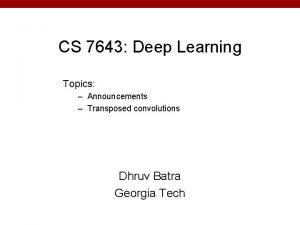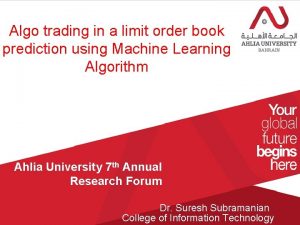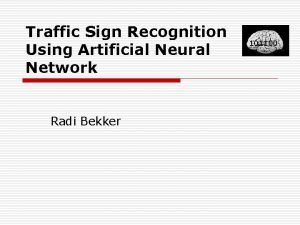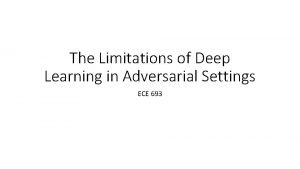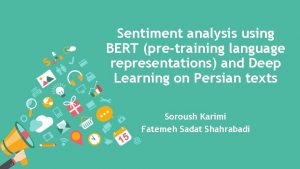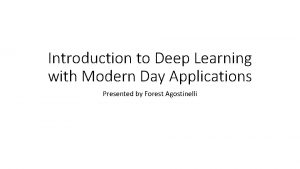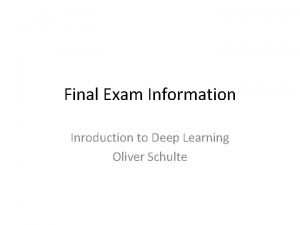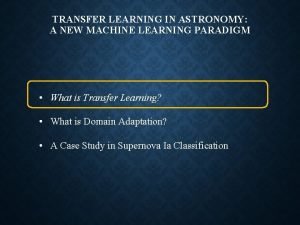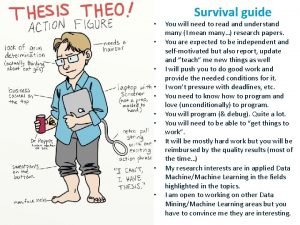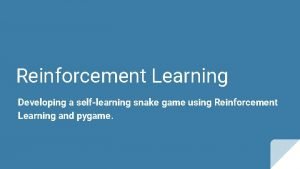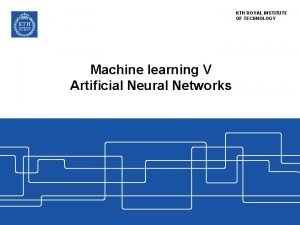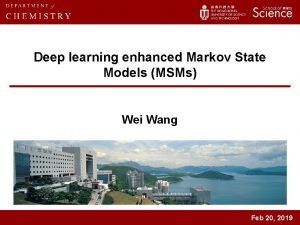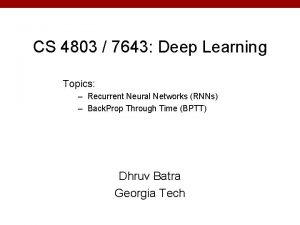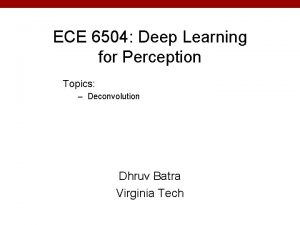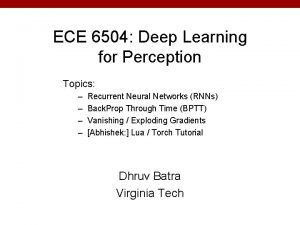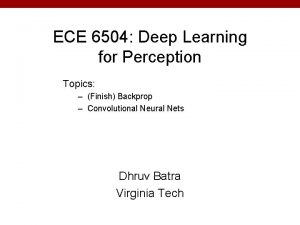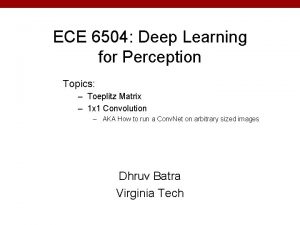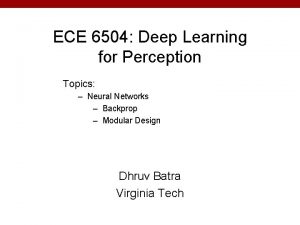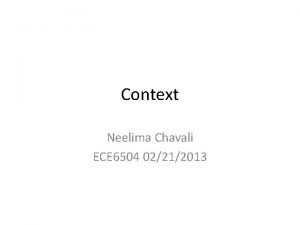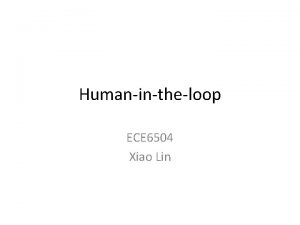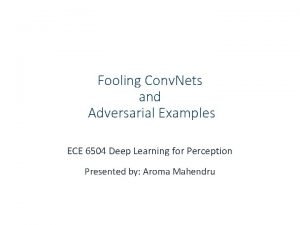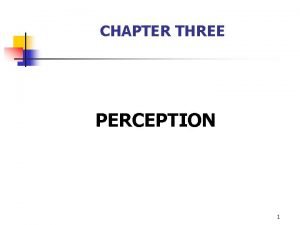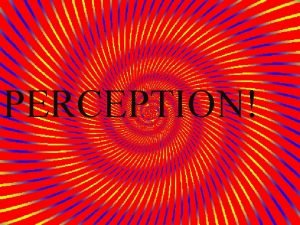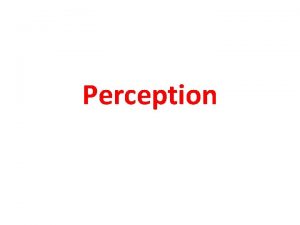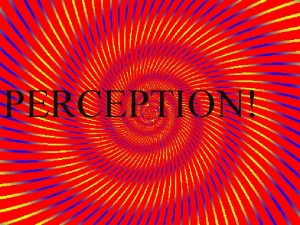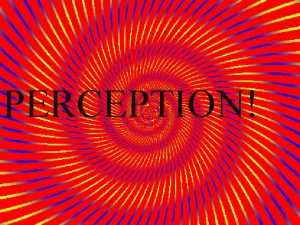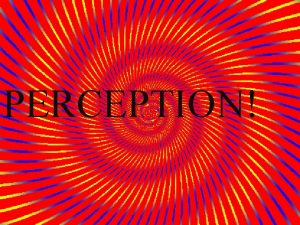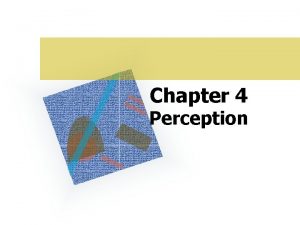ECE 6504 Deep Learning for Perception Introduction to






















































- Slides: 54

ECE 6504 – Deep Learning for Perception Introduction to CAFFE Ashwin Kalyan V

(C) Dhruv Batra 2

Logistic Regression as a Cascade (C) Dhruv Batra Slide Credit: Marc'Aurelio Ranzato, Yann Le. Cun 3

Logistic Regression as a Cascade (C) Dhruv Batra Slide Credit: Marc'Aurelio Ranzato, Yann Le. Cun 4

Logistic Regression as a Cascade (C) Dhruv Batra Slide Credit: Marc'Aurelio Ranzato, Yann Le. Cun 5

Key Computation: Forward-Prop (C) Dhruv Batra Slide Credit: Marc'Aurelio Ranzato, Yann Le. Cun 6

Key Computation: Back-Prop (C) Dhruv Batra Slide Credit: Marc'Aurelio Ranzato, Yann Le. Cun 7

Training using Stochastic Gradient Descent

Training using Stochastic Gradient Descent Loss functions of NN are almost always non-convex

Training using Stochastic Gradient Descent Loss functions of NN are almost always non-convex which makes training a little tricky. Many methods to find the optimum, like momentum update, Nesterov momentum update, Adagrad, RMSPRop, etc

Network • A network is a set of layers and its connections. • Data and gradients move along the connections. • Feed forward networks are Directed Acyclic graphs (DAG) i. e. they do not have any recurrent connections.

Neural nets Conv Nets Feed-back feed-forward Main types of deep architectures Stacked Auto-encoders DBM input (C) Dhruv Batra input Recurrent Bi-directional input Hierar. Sparse Coding Deconv Nets input Slide Credit: Marc'Aurelio Ranzato, Yann Le. Cun Recurrent Neural nets Recursive Nets LISTA 12

Neural nets Conv Nets Feed-back feed-forward Focus of this course Stacked Auto-encoders DBM input (C) Dhruv Batra input Recurrent Bi-directional input Hierar. Sparse Coding Deconv Nets input Slide Credit: Marc'Aurelio Ranzato, Yann Le. Cun Recurrent Neural nets Recursive Nets LISTA 13

Neural nets Conv Nets Feed-back feed-forward Focus of this class Stacked Auto-encoders DBM input (C) Dhruv Batra input Recurrent Bi-directional input Hierar. Sparse Coding Deconv Nets input Slide Credit: Marc'Aurelio Ranzato, Yann Le. Cun Recurrent Neural nets Recursive Nets LISTA 14

Neural nets Conv Nets Feed-back Why? Because official CAFFE release supports DAG feed-forward Focus of this class Stacked Auto-encoders DBM input (C) Dhruv Batra input Recurrent Bi-directional input Hierar. Sparse Coding Deconv Nets input Slide Credit: Marc'Aurelio Ranzato, Yann Le. Cun Recurrent Neural nets Recursive Nets LISTA 15

Outline • Caffe? • Installation • Key Ingredients • Example: Softmax Classifier • Pycaffe • Roasting • Resources • References 16

What is Caffe? Open framework, models, and worked examples for deep learning - 1. 5 years - 450+ citations, 100+ contributors - 2, 500+ forks, >1 pull request / day average - focus has been vision, but branching out: sequences, reinforcement learning, speech + text Prototype Train Deploy

What is Caffe? Open framework, models, and worked examples for deep learning - Pure C++ / CUDA architecture for deep learning - Command line, Python, MATLAB interfaces - Fast, well-tested code - Tools, reference models, demos, and recipes - Seamless switch between CPU and GPU Prototype Train Deploy

Installation

Installation

Installation • Strongly recommended that you use Linux (Ubuntu)/ OS X. Windows has some unofficial support though. • Prior to installing look at the installation page and the wiki - the wiki has more info. But all support needs to be taken with a pinch of salt - lots of dependencies • Suggested that you back up your data!

Installation • CUDA (Compute Unified Device Architecture) is a parallel computing platform and application programming interface (API) model created by NVIDIA • Installing CUDA – check if you have a cuda supported Graphics Processing Unit (GPU). If not, go for a cpu only installation of CAFFE. - Do not install the nvidia driver if you do not have a supported GPU

Installation • Clone the repo from here • Depending on the system configuration, make modifications to the Makefile. config file and proceed with the installation instructions. • We suggest that you use Anaconda python for the installation as it comes with the necessary python packages.

Quick Questions?

Key Ingredients

DAG SDS two-stream net Many current deep models have linear structure Goog. Le. Net Inception Module Caffe nets can have any directed acyclic graph (DAG) structure. LRCN joint vision-sequence model

Blobs are N-D arrays for storing and communicating information. ● hold data, derivatives, and parameters ● lazily allocate memory ● shuttle between CPU and GPU name: "conv 1" type: CONVOLUTION bottom: "data" top: "conv 1" … definition … top blob Data Number x K Channel x Height x Width 256 x 3 x 227 for Image. Net train input Parameter: Convolution Weight N Output x K Input x Height x Width 96 x 3 x 11 for Caffe. Net conv 1 Parameter: Convolution Bias 96 x 1 x 1 for Caffe. Net conv 1 bottom blob

Layer Protocol Setup: run once for initialization. Forward: make output given input. Backward: make gradient of output - w. r. t. bottom - w. r. t. parameters (if needed) Reshape: set dimensions. Compositional Modeling The Net’s forward and backward passes are composed of the layers’ steps. Layer Development Checklist

Layers • Caffe divides layers into - neuron layers (eg: Inner product), - Vision layers (Convolutional, pooling, etc) - Data layers (to read in input) - Loss layers • You can write your own layers. More development guidelines are here

Loss What kind of model is this? loss (LOSS_TYPE) Classification Softmax. With. Loss Hinge. Loss Linear Regression Euclidean. Loss Attributes / Multiclassificati Sigmoid. Cross. Entropy. Loss Others… Define the task by the loss. New Task New. Loss

Protobuf Model Format - Strongly typed format Auto-generates code Developed by Google Defines Net / Layer / Solver schemas in caffe. proto message Convolution. Parameter { // The number of outputs for the layer optional uint 32 num_output = 1; // whether to have bias terms optional bool bias_term = 2 [default = true]; } layer { name: "ip" type: "Inner. Product" bottom: "data" top: "ip" inner_product_param { num_output: 2 } }

Softmax Classifier

Neural Network

Activation function Rectified Linear Unit (Re. LU) Activation

Recipe for brewing a net • Convert the data to caffe-supported format LMDB, HDF 5, list of images • Define the net • Configure the solver • Start train from supported interface (command line, python, etc)

Layers – Data Layers • Data Layers : gets data into the net - Data: LMDB/LEVELDB efficient way to input data, only for 1 -of-k classification tasks - HDF 5 Data: takes in HDF 5 format - easy to create custom non-image datasets but supports only float 32/float 64 - Data can be written easily in the above formats using python support. ( using lmdb and h 5 py respectively). We will see how to write hdf 5 data shortly - Image Data: Reads in directly from images. Can be a little slow. - All layers (except hdf 5) support standard data augmentation tasks

Recipe for brewing a net • Convert the data to caffe-supported format LMDB, HDF 5, list of images • Define the network/architecture • Configure the solver • Start train from supported interface (command line, python, etc)

Example: Softmax Classifier Architecture file name: "Log. Reg" layer { name: "mnist" type: "Data" top: "data" top: "label" data_param { source: "input_leveldb" batch_size: 64 } }

Example: Softmax Classifier Architecture file name: "Log. Reg" layer { name: "mnist" type: "Data" top: "data" top: "label" data_param { source: "input_leveldb" batch_size: 64 } } layer { name: "ip" type: "Inner. Product" bottom: "data" top: "ip" inner_product_param { num_output: 2 } }

Example: Softmax Classifier Architecture file name: "Log. Reg" layer { name: "mnist" type: "Data" top: "data" top: "label" data_param { source: "input_leveldb" batch_size: 64 } } layer { name: "ip" type: "Inner. Product" bottom: "data" top: "ip" inner_product_param { num_output: 2 } } layer { name: "loss" type: "Softmax. With. Loss" bottom: "ip" bottom: "label" top: "loss" }

Recipe for brewing a net • Convert the data to caffe-supported format LMDB, HDF 5, list of images • Define the net • Configure the solver • Start train from supported interface (command line, python, etc)

Example: Softmax Classifier Solver file net: "logreg_train_val. prototxt” test_iter: 10 test_interval: 500 base_lr: 0. 0000001 momentum: 0. 0 weight_decay: 50000 lr_policy: "step” stepsize: 2000 display: 100 max_iter: 2000 snapshot: 1000 snapshot_prefix: "logreg-snapshot/” solver_mode: GPU

Example: Softmax Classifier Solver file net: "logreg_train_val. prototxt” test_iter: 10 test_interval: 500 base_lr: 0. 0000001 momentum: 0. 0 weight_decay: 50000 lr_policy: "step” stepsize: 2000 display: 100 max_iter: 2000 snapshot: 1000 snapshot_prefix: "logreg-snapshot/” solver_mode: GPU CAFFE has many common solver methods: Ø SGD Ø Adagrad Ø RMSProp Ø Nesterov Momentum, etc More details in this page

Recipe for brewing a net • Convert the data to caffe-supported format LMDB, HDF 5, list of images • Define the net • Configure the solver • Train from supported interface (command line, python, etc)

Softmax Classifier Demo Command line interface < Ipython notebook>

Pycaffe Demo Softmax Classifier example on pycaffe

Need for tuning Hyper - parameters Figure on the left has a high learning rate and the loss on the training set does not converge. When hyper-parameters like learning rate and weight-decay are tuned, the loss decreases rapidly as shown in the figure on the right.

Logging • It is use full to generate a log file where caffe dumps values like training loss, iteration number, norm of the weights of each blob, etc. • Parse log file to obtain useful hints about training process - see caffe/tools/extra/parse_log. py • The above is a generic function. Custom log parsing can be created by you keeping the above as an example.

Log Parse Demo

Pycaffe Demo • pycaffe to visualize weights of a pre-trained model • Model Zoo has pretrained models of deep learning architectures like alexnet • Running a forward pass to - predict class Pycaffe documentation is sparse! Looking at examples and reading code is inevitable if you want to make the best use of CAFFE!

Up Next The Latest Roast Detection Sequences Pixelwise Prediction Framework Future

Resources • Many examples are provided in the caffe-master/examples directory • Ipython notebooks for common Neural network tasks like filter visualization, fine-tuning, etc • Caffe-tutorials • Caffe chat • Caffe-users group • Watch out for new features!

References 1. http: //caffe. berkeleyvision. org/ 2. DIY Deep Learning for Vision with Caffe

THANK YOU
 Deep learning vs machine learning
Deep learning vs machine learning Deep learning approach and surface learning approach
Deep learning approach and surface learning approach Deep asleep deep asleep it lies
Deep asleep deep asleep it lies Deep forest towards an alternative to deep neural networks
Deep forest towards an alternative to deep neural networks 深哉深哉耶穌的愛
深哉深哉耶穌的愛 Cuadro comparativo e-learning b-learning m-learning
Cuadro comparativo e-learning b-learning m-learning Operator fusion deep learning
Operator fusion deep learning Lstm andrew ng
Lstm andrew ng Hortonworks gpu
Hortonworks gpu Gandiva: introspective cluster scheduling for deep learning
Gandiva: introspective cluster scheduling for deep learning He kaiming
He kaiming Deep learning speech recognition
Deep learning speech recognition Cs 4803
Cs 4803 Autoencoders
Autoencoders Supervised vs unsupervised learning
Supervised vs unsupervised learning Sachin tendulkar
Sachin tendulkar Who is the father of deep learning?
Who is the father of deep learning? Regretnet
Regretnet Deep learning competencies 6 c's
Deep learning competencies 6 c's Neural network cost function
Neural network cost function Bird eye view deep learning
Bird eye view deep learning Jeff heaton deep learning
Jeff heaton deep learning Fast distributed deep learning over rdma
Fast distributed deep learning over rdma Deep learning dummies
Deep learning dummies Deep learning for dummies
Deep learning for dummies Cs 7643 deep learning
Cs 7643 deep learning Moe deep learning
Moe deep learning Xkcd machine learning
Xkcd machine learning Intel deep learning training tool
Intel deep learning training tool Deploying deep learning models with docker and kubernetes
Deploying deep learning models with docker and kubernetes Caffe tutorial
Caffe tutorial Caffe tutorial
Caffe tutorial Statistical mechanics of deep learning
Statistical mechanics of deep learning Student teacher neural network
Student teacher neural network Optimal transport deep learning
Optimal transport deep learning Playground tensor
Playground tensor Aditya kanade
Aditya kanade Deep learning yoshua bengio authors
Deep learning yoshua bengio authors Cs 7643
Cs 7643 Deep learning for limit order books
Deep learning for limit order books Traffic sign recognition deep learning
Traffic sign recognition deep learning The limitations of deep learning in adversarial settings
The limitations of deep learning in adversarial settings Bert confusion matrix
Bert confusion matrix Deep learning
Deep learning Deep learning final exam
Deep learning final exam Deep learning spectroscopy
Deep learning spectroscopy Deep learning captcha
Deep learning captcha Reinforcement learning snake game
Reinforcement learning snake game Supervised learning dan unsupervised learning
Supervised learning dan unsupervised learning Kth machine learning
Kth machine learning Vampnets for deep learning of molecular kinetics
Vampnets for deep learning of molecular kinetics Cs 7643 deep learning
Cs 7643 deep learning Formuö
Formuö Typiska novell drag
Typiska novell drag Nationell inriktning för artificiell intelligens
Nationell inriktning för artificiell intelligens






